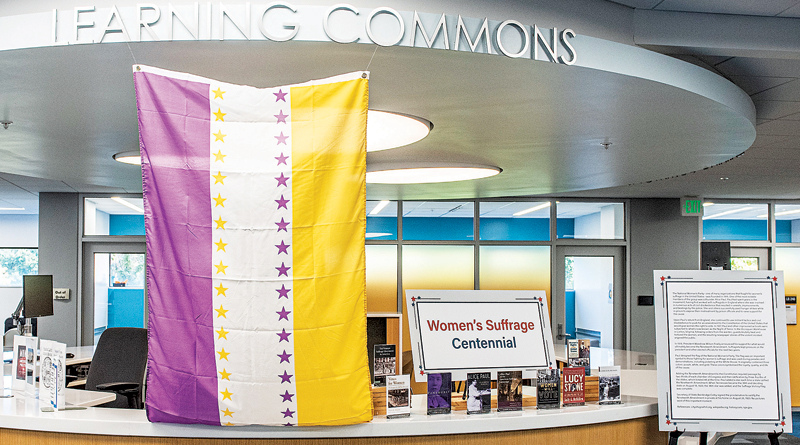SUFFRAGE VICTORY FLAG CELEBRATES 100TH ANNIVERSARY

A century after U.S. women first earned the hard-fought right to vote in public elections via ratification of the 19th Amendment to the Constitution, important issues related to this essential aspect of democracy continue to take center stage just four weeks to the day before the 2020 general election.
To raise awareness of the 19th Amendment, and to encourage an open dialogue about the nation’s willingness to support access to voting for all those who are eligible, Purdue University Fort Wayne is displaying a replica Suffrage Victory Flag at the Walter E. Helmke Library. The flag and other informational materials are located at a service desk near study rooms on the north wall of the library’s second floor.
“One hundred years ago, the evolution of this flag served as a visual demonstration of the progress being made toward ratification of the 19th Amendment,” said Janet Badia, professor and director of Women’s Studies at Purdue Fort Wayne. “Today, we can admire the flag and be reminded of an important lesson: namely, that progress is often slow and it often encounters many hurdles; but nevertheless, we persist.”
The National Woman’s Party — one of many organizations that fought for women’s suffrage in the United States — was founded in 1916. One of the most notable members of the group was cofounder Alice Paul. Paul had spent years in the movement, having first worked with suffragists in England where she was involved in numerous acts of civil disobedience that resulted in arrests, imprisonments, and beatings by the police. She and others successfully used hunger strikes while in prison to expose their mistreatment by prison officials and to raise support for the cause.
Upon Paul’s return from England, she continued to use militant tactics and civil disobedience to push for an amendment to the Constitution of the United States that would give women the right to vote. In 1917, Paul and other imprisoned activists were subjected to what’s now known as the Night of Terror. In the Occoquan Workhouse in Lorton, Virginia, following orders from the warden, guards brutally beat and tortured the women, and the resulting newspaper stories of the violent incident angered the public.
In 1918, President Woodrow Wilson finally announced his support for what would ultimately become the 19th Amendment. Suffragists kept pressure on the president and other elected officials for the next two years.
Paul designed the flag of the National Woman’s Party. The flag was an important symbol to those fighting for women’s suffrage and was used during parades and demonstrations, including picketing at the White House. It originally contained three colors: purple, white, and gold. These colors symbolized the loyalty, quality, and life of the cause.
Adding the 19th Amendment to the Constitution required passage by two-thirds of each chamber of Congress and then ratification by three-fourths of the states, which totaled 48 at the time. Paul added a star each time a state ratified the 19th Amendment. When Tennessee became the 36th and deciding state on Aug. 18, 1920, the 36th star was added, and the Suffrage Victory Flag was complete.
Secretary of State Bainbridge Colby signed the proclamation to certify the 19th Amendment in private at his home on Aug. 26, 1920. No pictures exist of this important moment.
- Celebrating 20 Years Of Community At The Stand - April 12, 2024
- First Positive Case Of Chronic Wasting Disease In Indiana - April 12, 2024
- Southwest Allen County Schools Embark On Major Tree Plantings - April 12, 2024


